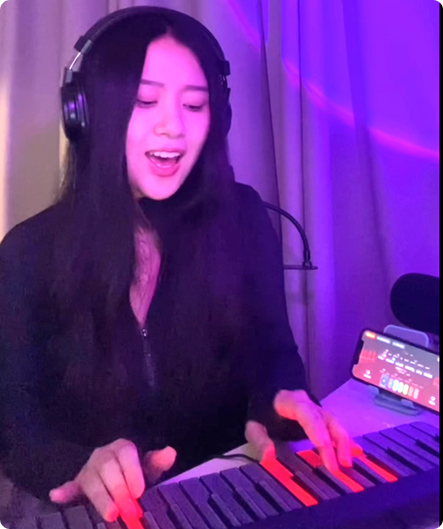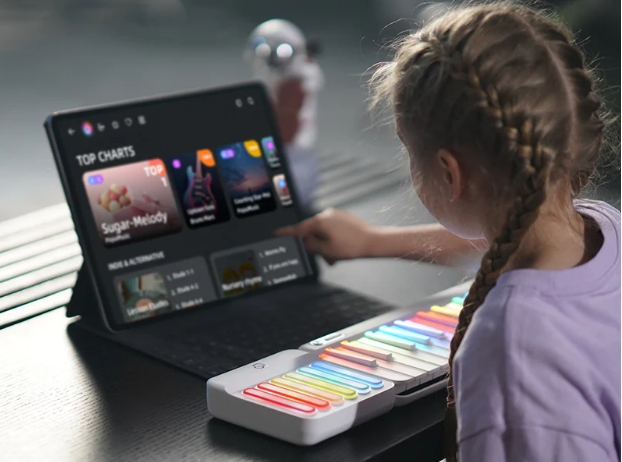
Plenty of new players stare at a slim electronic keyboard and wonder, “Can you learn piano on a keyboard?” Short answer: yes, you can, and thousands do every year. The long answer—covered below—explains the gear you’ll need, the habits that matter, and the moment you might want to upgrade.
We’ll also look at whether you can learn piano on a MIDI keyboard and highlight a nifty option—the Smart Keyboard that blends learning tools with real‑instrument feel.
An acoustic piano produces sound with hammers and strings, while a keyboard relies on digital samples piped through speakers or headphones. That core difference affects two learning factors:
Yes. Modern digital keyboards check off every box a starter needs: touch sensitivity (the harder you press, the louder it sounds), sustain‑pedal input, and a realistic sample library.
Add in volume control—a lifesaver in apartments—and you’ve got a practice buddy that won’t upset the neighbors. A Massachusetts studio even prefers digital boards for online lessons because they transmit cleaner sound over Zoom.
Make “touch sensitivity” the first spec you verify. Without it, you can’t practice soft vs. loud playing, and the jump to an acoustic instrument later feels jarring.
A MIDI keyboard is a controller with no built‑in speakers; it sends data to a computer or tablet where virtual instruments produce the tones. Can you learn piano on a MIDI keyboard? Sure, and apps like Melodics pitch the idea hard—the company touts cost savings, portability, and built‑in progress tracking.
Pros
Cons
If production and songwriting are on your bucket list, a MIDI board kills two birds. If solo piano is your endgame, aim for an 88‑key hammer‑action MIDI controller (think Arturia KeyLab 88 Mk II) so you’re practicing with realistic resistance.
|
Must‑Have |
Why It Matters |
|
88 keys (or at least 76) |
Lets you tackle Grade 5+ repertoire without transposing |
|
Weighted/hammer action |
Builds strength; prepares you for acoustic grands |
|
Velocity sensitivity |
Teaches dynamic control and articulation |
|
Sustain‑pedal jack |
Half the beginner repertoire needs pedal lines |
|
Polyphony ≥ 64 voices |
Prevents note drop‑outs in pedaled passages |
Keyboards that hit those marks—Yamaha P‑125, Roland FP‑10, Casio PX‑S1100—feel worlds apart from toy store models.
If you like gadgets, PopuMusic’s Smart Keyboard is a playful bridge between gaming and real musicianship. Rainbow‑lit keys pulse in sync with lessons, guiding you to each note while an accompanying app gamifies practice.
Under the hood you still get practical specs—256 tones, 100+ chord presets, sustain‑pedal support, and full MIDI out—so it doubles as a production controller. Pretty magical, right?
Gear helps, but fingers seal the deal. Keep these habits front‑and‑center:
You can cover method‑book tunes and pop leads, but Beethoven’s Moonlight Sonata? Not so much. Plan to upgrade once you hit late beginner stage.
Possible, yet you’ll spend extra months relearning dynamics later. If budget forces your hand, pick something with velocity sensitivity, then practice softer passages consciously.
Yes—exam boards allow digital pianos that meet touch‑weight and pedal specs. Just book occasional sessions on an acoustic grand to acclimate.
Absolutely. Route it through a high‑quality piano plugin (e.g., Pianoteq, Keyscape) and you’ll hear nuances close to the real thing.
Fold‑out 25‑key controllers help maintain finger dexterity on trips; pair them with an iPad sound engine and you’re good.
Signs you’ve outgrown your board:
Rent an acoustic room for an hour each month—many colleges and community centers offer this—to develop touch color and pedaling finesse. Digital practice plus periodic acoustic exposure gives you the best of both worlds.
So, can you learn piano on a keyboard? Completely. Whether you choose a weighted digital piano, a MIDI controller, or a light‑up board like PopuPiano, the instrument is merely the vehicle.
Your consistency, curiosity, and willingness to listen back are the real engine. Plug in, press record, and let the journey begin. We'll be cheering from the sidelines—quietly, with headphones on.
Leer más

Electronic Musical Instruments in 2025: A Friendly Guide to Gear That Sparks Creativity
Walk into any bedroom studio today and you’ll spot blinking pads, light‑up keys, and travel‑sized synths sitting next to laptops. Sales keep climbing: analysts expect the global electronic musical ...

Is a Piano Really an Instrument? Breaking Down the Music Science
Is a piano an instrument? At first glance, the answer seems obvious, but dig a little deeper, & things get more interesting. Unlike most instruments that fall neatly into one category, the pian...